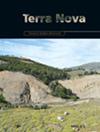2008年汶川地震激活的天然断层泥中碳颗粒的结构结构
IF 1.7
3区 地球科学
Q2 GEOSCIENCES, MULTIDISCIPLINARY
引用次数: 0
摘要
2008年汶川地震后重新激活的天然断层泥在发震断层带的浅部通常富含碳。尽管实验证据表明,在地震滑移过程中,无定形碳可以转变为石墨,但这种转变在自然界中尚未观察到。我们使用高分辨率透射电子显微镜对汶川地震相关表面破裂的富碳共震泥进行了纳米级研究。我们发现,所有的矿物颗粒都包裹在无定形碳质材料中,具有正弦和直石墨烯层堆叠。正弦层是瞬态材料(~0.3456 nm)通过无定形碳转化为石墨而形成;石墨烯层是石墨薄片(0.3354 nm)。这意味着,在以前的地震周期中,浅滑动带的矿物颗粒表面(凹凸)发生了石墨化,这可能会降低同震断层泥的摩擦强度,并解释龙门山发震断层带浅部的动力学弱点。本文章由计算机程序翻译,如有差异,请以英文原文为准。
Structural fabrics of carbon grains in a natural fault gouge reactivated by the 2008 Wenchuan earthquake
Natural fault gouges reactivated by the 2008 Wenchuan earthquake are typically rich in carbon in shallow parts of the seismogenic fault zone. Although experimental evidence indicates that amorphous carbon can be changed to graphite during seismic slips, this transformation has not yet been observed in nature. We conducted a nanoscale investigation of a carbon‐rich co‐seismic gouge from a surface rupture related to the Wenchuan earthquake using high‐resolution transmission electron microscopy. We found that all mineral grains were wrapped in amorphous carbonaceous materials with sinuate and straight graphene layer stacks. The sinuate layer was the transient material (~0.3456 nm) formed by amorphous carbon transforming to graphite; the graphene layer was graphite flakes (0.3354 nm). This means that graphitization occurred on the mineral grain surfaces (asperities) in the shallow slip zones during previous earthquake cycles, which could decrease the friction strength of the co‐seismic fault gouge and explain the dynamic weakness of the shallow parts of the Longmenshan seismogenic fault zone.
求助全文
通过发布文献求助,成功后即可免费获取论文全文。
去求助
来源期刊

Terra Nova
地学-地球科学综合
CiteScore
4.80
自引率
8.30%
发文量
59
审稿时长
2.3 months
期刊介绍:
Terra Nova publishes short, innovative and provocative papers of interest to a wide readership and covering the broadest spectrum of the Solid Earth and Planetary Sciences. Terra Nova encompasses geology, geophysics and geochemistry, and extends to the fluid envelopes (atmosphere, ocean, environment) whenever coupling with the Solid Earth is involved.
 求助内容:
求助内容: 应助结果提醒方式:
应助结果提醒方式:


